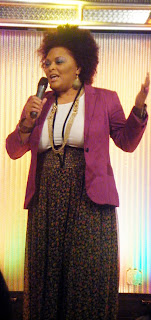
By Bonita Holmes
I took my seat among the crowd of spectators at the Arie Crown Theater on May 19, 2010 with a mind full of anticipation and prejudgment. The humble cast of Angela Barrow-Dunlap’s “Church Girl” provided me with a prelude to the play, which made the experience comforting and inspirational. Naturally, I assumed that “Church Girl” would convey what most urban, African American stage productions accomplish—the cliché tales of the lives of people in the black church culture. However, unknowingly, “Church Girl” would uplift me spiritually and open my eyes to so many new ideas.
The production, which featured such stars as Robin Givens, Drew Sidora, A’ngela Wimbush, Demetria McKinney and Sean Blakemore, opened up to a typical church scene where precisely dressed middle-aged women bellowed the sounds of the gospel. Style and class were the themes of the cast’s wardrobe. Every individual who graced the stage modeled off their “Sunday’s Best.” Their clothing sparkled, allowing their performances to be all the more exciting. Demetria McKinney, who portrayed the role of Emily Franklin, the lead character and ultimately the good girl gone bad, brought innocence and lust to the stage. Her character emphasized the power of love, hate and how easily one can be misled by friends, men and life.
Robin Givens, who portrayed a role she has often done in the past, nearly mastered this idea of a scorn woman leaning on a man for comfort and protection. Her character Cat Jones is stylish, witty and the reason why Emily’s secret life no longer remains hidden. For some reason, the character Cat Jones is alternated between Givens and Drew Sidora who didn’t have the opportunity to perform on this particular night.
A’ngela Wimbush brought a strong presence to the stage with her stunning voice and motherly affection. Her character, Maya Franklin represented the typical black woman—strong, and God fearing yet hurt by a troubled marriage. She is indirectly living her life through her daughter, which causes Emily to become rebellious. Sean Blakemore portrays the suave, classy, yet greedy and manipulative Jacob Sinclair. This character is the epitome of a woman’s weakness whose devilish ways are overcome by a congregation’s belief in God.
The stage design was quite impressive, although it only seemed to alternate between a church and a night club, and the music consisted of selections which catered to all age groups. A blend of gospel, hip hop and R&B allowed the characters to also tell their stories through song, which eventually became annoying and predictable. The other downside was how long the play became, and soon each scene started becoming drawn out, leaving no time for the main point of the plot.
“Church Girl” was an interesting tale of a young woman who started off on the right path but allowed the cruelties of life to trick her into a dangerous lifestyle. The play is about overcoming triumph and getting over your pride to be where you should be in life. I would recommend “Church Girl” to the 30 and above crowd only because it seems that they’d receive the messages on a greater level.
Let Bonita know what you think of her review by leaving your comments here or sending her an email to Bonita@glossmagazineonline.com. Also, check out her GMO Feature article on the play here!



























